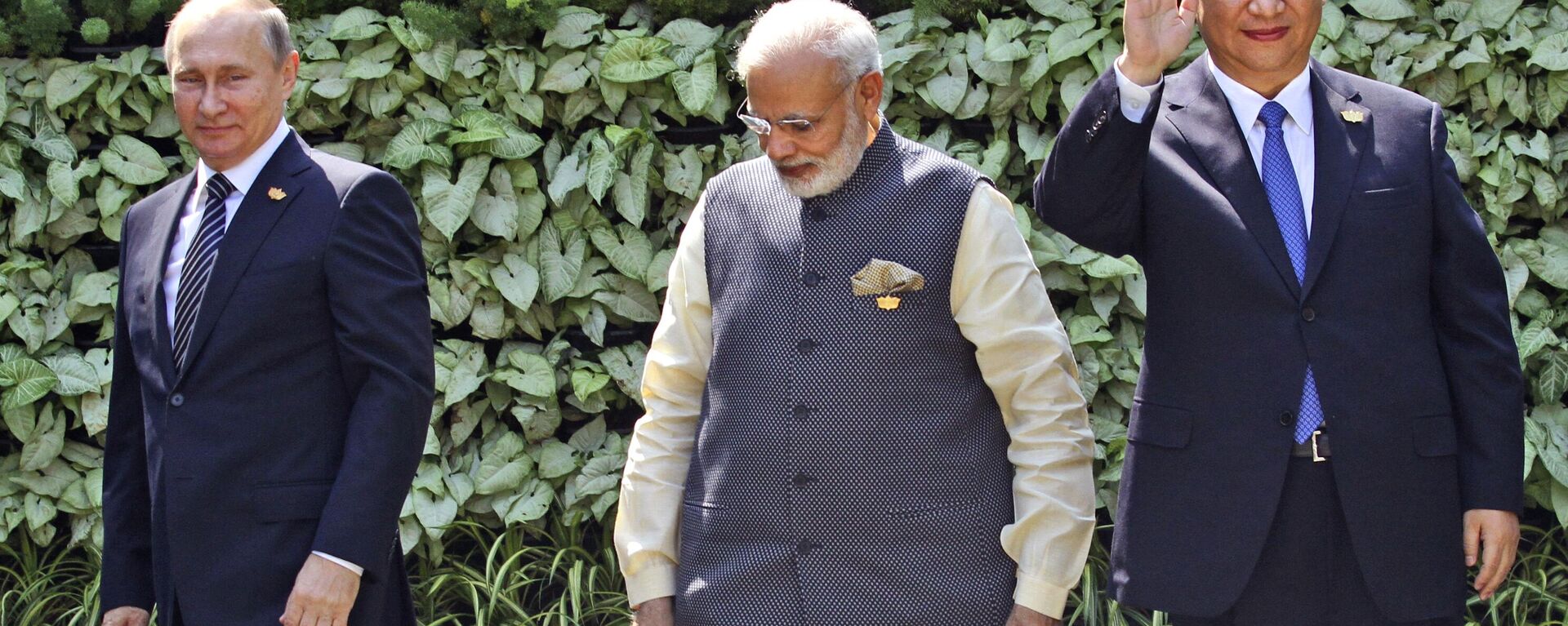https://sputniknews.in/20240508/has-the-us-replaced-quad-with-squad-7320183.html
Has the US Replaced Quad With Squad?
Has the US Replaced Quad With Squad?
Sputnik India
There are suggestions that the Biden administration has prioritised a new combat alliance of four nations, privately referred to as the 'Squad', over the Quad, another US-led grouping also comprising Australia, Japan and India.
2024-05-08T16:02+0530
2024-05-08T16:02+0530
2024-05-08T16:02+0530
sputnik opinion
joe biden
lloyd austin
narendra modi
us
india
china
people's liberation army (pla)
quad
indian navy
https://cdn1.img.sputniknews.in/img/07e7/06/0f/2505864_0:0:3072:1728_1920x0_80_0_0_8dcce9b58b8cc406a277f77578779220.jpg
There are suggestions that the Biden administration has prioritised a new combat alliance of four nations, privately referred to as the 'Squad', over the Quad, another US-led grouping also comprising Australia, Japan and India.Japanese publication Nikkei Asian Review quoted Ashley Tellis, a former special assistant to President George W. Bush, as stating that Quad was only "one arrow among many in the US quiver" to balance China.The institutionalisation of the Squad, which, unlike the Quad, comprises treaty allies of the US, comes against the backdrop of increasing tensions in the South China Sea between Beijing and Manila.In April, warships and aircraft from the four nations conducted a joint patrol in the South China Sea after the Chinese Coast Guard vessels blocked a Philippine "re-supply mission" at the second Thomas Shoal, whose sovereignty remains disputed.Has the Quad Lost its Relevance for the US?There are suggestions in the media that the Biden administration has run out of patience with India over its refusal to fall in line with the US diktat on the Ukraine conflict, unlike the other Quad partners.Despite a nearly four-year long border standoff with China in eastern Ladakh, New Delhi has been viewed as wary of joining the US-led alliance system, the primary goal of which is to contain Beijing's expanding influence.The Indian analyst suggested that the US had Quad focusing primarily on the Indian Ocean, while Squad was catering to the "hotspots" of Taiwan and South China Sea, where risks of a conflict with China were higher."Firstly, the signing of the Master Ship Repair Agreements between India and the US during Prime Minister Modi's state visit to Washington last June means that Indian ports would serve as a hub of maintenance and repair of US naval assets in the region," Sawhney said, adding that both the countries were working together to create logistics for maintenance and repair of US aerial assets too.He explained that these pacts have led to the "shortening of the operational turnaround" of American ships travelling from the US Fifth Fleet headquarter in Bahrain to Western Pacific.Sawhney said that the Indian Navy, as part of its "combat-support role" would also provide an escort to western navies without getting directly involved in combat operations.Thirdly, Sawhney said that India had become part of US Maritime Domain Awareness (MDA) programme in Indo-Pacific, signified by stationing of US and other western liaison officers at the Information Fusion Centre-Indian Ocean Region (IFC-IOR) in Gurugram.Indian Navy veteran Commodore (retired) Seshadri Vasan, the Director General of Chennai Centre for China Studies (C3S) and the Regional Director of National Maritime Foundation (NMF), said that New Delhi has always been clear about the fact that Quad wasn't a military alliance.He noted that the US intention is clearly ramp up pressure on China through groupings such as Quad, Aukus and now Squad.Hotspots in South China SeaCiting comments by US military leadership, Sawhney claimed that the US seriously believed that Beijing would accomplish its goal of "reunification" with Taiwan, if needed by force, by 2027, which is the 100th anniversary of the founding of the People's Liberation Army (PLA).Chinese President Xi Jinping told US President Joe Biden during their San Francisco summit that China would reunify Taiwan. Beijing has not abandoned the use of force, though it has said that it favoured a peaceful reunification.He said that as part of its strategy to bolster deterrence, the US was focused on increasing its capability and credibility."So, in recent months, the US ensured that it gets access to more military bases in the Philippines, Japan and South Korea," the Indian expert said.
https://sputniknews.in/20240419/modis-comments-on-china-a-warning-shot-for-us-analysts-say--7168270.html
us
india
china
the philippines
south china sea
taiwan
japan
australia
south korea
indo-pacific
pacific ocean
indian ocean
southeast asia
Sputnik India
feedback.hindi@sputniknews.com
+74956456601
MIA „Rossiya Segodnya“
2024
Dhairya Maheshwari
https://cdn1.img.sputniknews.in/img/07e6/0c/13/138962_0:0:641:640_100x100_80_0_0_2cb44360dbcdf6d84bf4b299cd045917.jpg
Dhairya Maheshwari
https://cdn1.img.sputniknews.in/img/07e6/0c/13/138962_0:0:641:640_100x100_80_0_0_2cb44360dbcdf6d84bf4b299cd045917.jpg
News
en_IN
Sputnik India
feedback.hindi@sputniknews.com
+74956456601
MIA „Rossiya Segodnya“
Sputnik India
feedback.hindi@sputniknews.com
+74956456601
MIA „Rossiya Segodnya“
Dhairya Maheshwari
https://cdn1.img.sputniknews.in/img/07e6/0c/13/138962_0:0:641:640_100x100_80_0_0_2cb44360dbcdf6d84bf4b299cd045917.jpg
quad summit, squad, squad philippines, south china sea dispute, south china sea news, china us news, china us relations, china us war, china us trade, taiwan news, quad summit, modi news, modi speech, lok sabha elections, ladakh dispute, russia india ties, russian oil exports to india
quad summit, squad, squad philippines, south china sea dispute, south china sea news, china us news, china us relations, china us war, china us trade, taiwan news, quad summit, modi news, modi speech, lok sabha elections, ladakh dispute, russia india ties, russian oil exports to india
Has the US Replaced Quad With Squad?
US Defence Secretary Lloyd Austin said last week that US, Japan, Australia and the Philippines “share a vision for peace, stability and deterrence in the Indo-Pacific” and have “chartered an ambitious course to advance that vision together.”
There are suggestions that the Biden administration has prioritised a new combat alliance of four nations, privately referred to as the 'Squad', over the Quad, another US-led grouping also comprising Australia, Japan and India.
"Move over, Quad; the new Squad has landed," announced a headline in Asia Times, days after the US Defence Secretary Lloyd Austin hosted his Philippine, Japanese and Australian counterparts for a meeting in Hawaii, the home of US Indo-Pacific Command (USINDOPACOM).
Japanese publication Nikkei Asian Review quoted Ashley Tellis, a former special assistant to President George W. Bush, as stating that Quad was only "one arrow among many in the US quiver" to balance China.
The institutionalisation of the Squad, which, unlike the Quad, comprises treaty allies of the US, comes against the backdrop of increasing tensions in the South China Sea between Beijing and Manila.
In April, warships and aircraft from the four nations conducted a joint patrol in the South China Sea after the Chinese Coast Guard vessels blocked a Philippine "re-supply mission" at the second Thomas Shoal, whose sovereignty remains disputed.
Has the Quad Lost its Relevance for the US?
There are suggestions in the media that the Biden administration has run out of patience with India over its
refusal to fall in line with the US diktat on the Ukraine conflict, unlike the other Quad partners.
Despite a nearly four-year long border standoff with China in eastern Ladakh, New Delhi has been viewed as wary of joining the US-led alliance system, the primary goal of which is to contain Beijing's expanding influence.
Pravin Sawhney, a strategic affairs analyst and author, told Sputnik India that in spite of the emergence of the Squad, the Quad continued to remain "important" for the US.
"But, what appears to have happened in the American thinking is that the Western Pacific Ocean Region has become the top US priority. The Indian Ocean Region (IOR) is now their second priority, which is largely due to huge volumes of trade passing through the IOR," Sawhney stated.
The Indian analyst suggested that the US had Quad focusing primarily on the Indian Ocean, while Squad was catering to the "hotspots" of Taiwan and South China Sea, where risks of a conflict with China were higher.
He explained that India was playing a "combat-support role" in the Quad, as opposed to "direct combat role" which was donned by US treaty allies such as Japan, Australia, the Philippines and even South Korea for that matter.
"Firstly, the signing of the Master Ship Repair Agreements between India and the US during Prime Minister Modi's state visit to Washington last June means that Indian ports would serve as a hub of maintenance and repair of US naval assets in the region," Sawhney said, adding that both the countries were working together to create logistics for maintenance and repair of US aerial assets too.
He explained that these pacts have led to the "shortening of the operational turnaround" of American ships travelling from the US Fifth Fleet headquarter in Bahrain to Western Pacific.
Sawhney said that the Indian Navy, as part of its "combat-support role" would also provide an escort to western navies
without getting directly involved in combat operations.
Thirdly, Sawhney said that India had become part of US Maritime Domain Awareness (MDA) programme in Indo-Pacific, signified by stationing of US and other western liaison officers at the Information Fusion Centre-Indian Ocean Region (IFC-IOR) in Gurugram.
Indian Navy veteran Commodore (retired) Seshadri Vasan, the Director General of Chennai Centre for China Studies (C3S) and the Regional Director of National Maritime Foundation (NMF), said that New Delhi has always been clear about the fact that Quad wasn't a military alliance.
"India has been clear that Quad is not a military alliance, but we will contribute to the process of ensuring maritime security for the region and partner countries", stated Vasan.
He noted that the US intention is clearly ramp up pressure on China through groupings such as Quad, Aukus and now Squad.
"There is clearly an intention to ramp up pressure on China in view of recent hostile encounters involving Chinese, Philippine and even Australian assets in the South China Sea," Vasan said.
Hotspots in South China Sea
Citing comments by US military leadership, Sawhney claimed that the US seriously believed that Beijing would accomplish its goal of "reunification" with Taiwan, if needed by force, by 2027, which is the 100th anniversary of the founding of the People's Liberation Army (PLA).
Chinese President Xi Jinping told US President Joe Biden during their San Francisco summit that China would reunify Taiwan. Beijing has not abandoned the use of force, though it has said that it favoured a peaceful reunification.
"The whole gameplan of the Americans seems to be focused on constraining the People's Liberation Army (PLA) within the 'First Island Chain' in the western Pacific Ocean region. So, the US has been strengthening the deterrence of its alliances there," Sawhney said.
He said that as part of its strategy to bolster deterrence, the US was focused on increasing its capability and credibility.
"So, in recent months, the US ensured that it gets access to more military bases in the Philippines, Japan and South Korea," the Indian expert said.
Sawhney highlighted that while China viewed Taiwan as its existential red line, external interference in the South China Sea issue was seen as an "economic red line" by Beijing.
"This is because the majority of its trade and energy imports pass through the South China Sea. But, with the Squad in the picture, we are going to witness an increase in intensity of combat patrols by US and its treaty allies in West Pacific," the Indian expert concluded.



